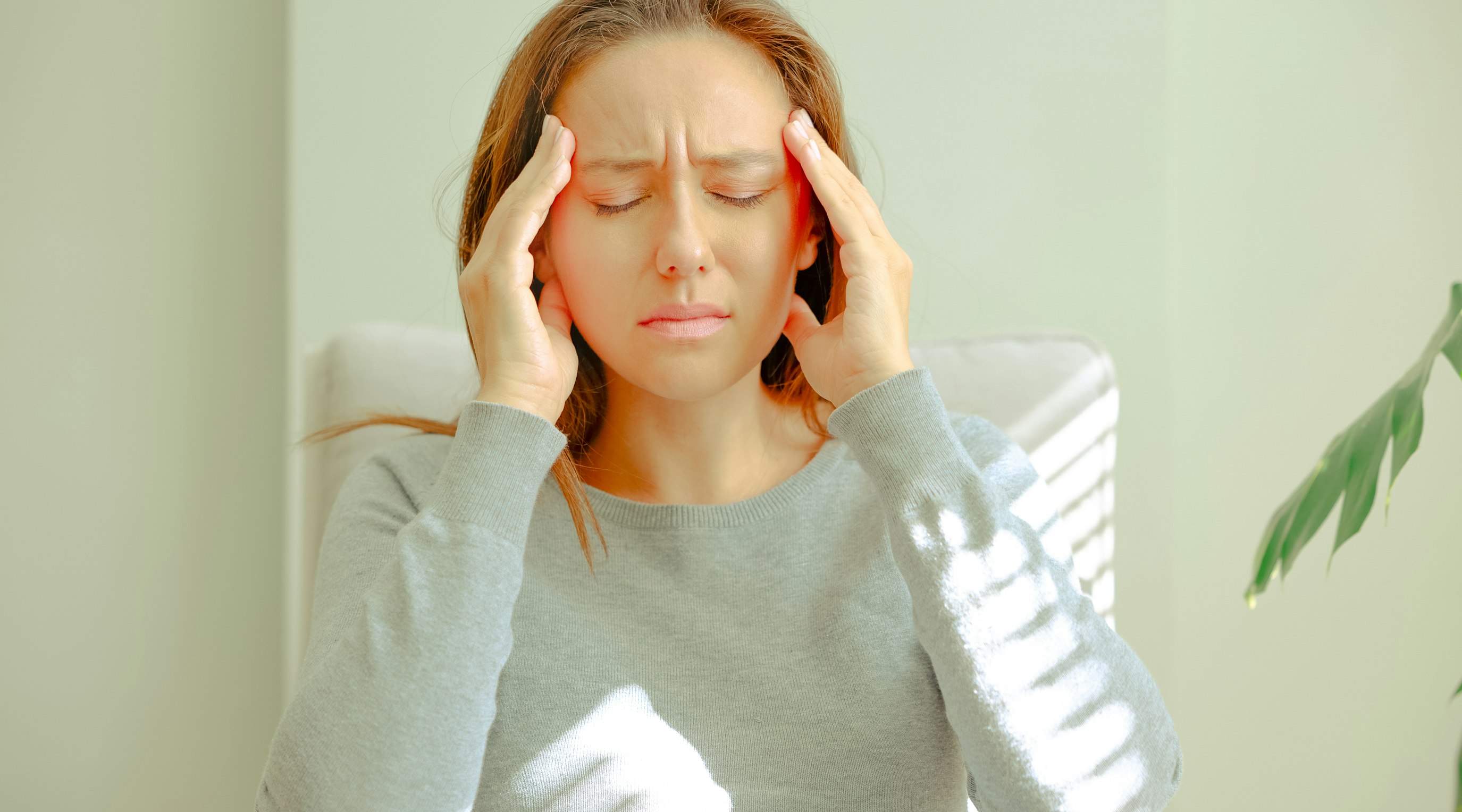Migraines are a common neurological condition that is characterised by a severe headache (often on one side), sensitivity to light or sound, and fatigue. Over 6 million people in the UK suffer from migraines. There are over 190,000 migraine attacks per day in the UK, so imagine how much disruption to home and work life this health issue causes. More women than men develop this complex neurological condition.
Contents
Migraine’s symptoms can be unpredictable and debilitating, whether they occur daily or occasionally. The overbearing sensations during a migraine attack can distort vision and make a person feel nauseous. Migraines can last minutes, hours, or even days.
Migraine patients frequently report some level of anxiety during a period of migraines, since they never know when an attack might occur. Everyday sensations that include lighting, smells, climate factors, and stress might spark a severe attack. When people discuss migraines, they are also referring to a broad range of mental and physical challenges.
A brief overview of migraines and their prevalence
While the true underlying factors that cause migraines are, as yet, unknown, it is thought that abnormal brain activity impacts chemical signals, nerve signals, and blood vessels in the brain.
According to the Migraine Trust, there are many types of migraines. While these types of migraines are quite varied, they are split into three main groups:
- A migraine with an aura - An aura is a warning sign or sensation right before a migraine begins.
- A migraine without any aura - This type of migraine comes with no warning, and can happen quickly.
- A migraine aura without any signs of a headache - The warning signs of a migraine, but no actual pain.
The pain of a migraine is sometimes attributed to the dilation of blood vessels. The blood vessels can start to constrict well before the attack, usually during the aura stage. As the attack progresses, the vessels may constrict further and cause intense discomfort. Patients describe distorted vision, distorted perception, extreme light and noise sensitivity, and queasiness in addition to the pain.
Neurologists believe genetics may play a key role in the origins of migraine disorder, but temperature, diet, stress, and other factors also seem to determine the onset, frequency, and intensity of migraine activity. Current research is looking into the diverse reasons that might contribute to migraine.
Explanation of cannabis as a potential treatment option
Medical cannabis may be a viable therapeutic addition for migraine patients. For those who have tried a range of conventional medications with no respite, CBD, THC, and the rest of the therapeutic cannabis compounds may be a last resort for relief.
The science behind migraines and medicinal cannabis
Emerging research has revealed some fascinating and promising findings regarding migraine pain and medical cannabis. Many studies are highlighting the potential effectiveness of medicinal cannabis to address a range of mental and physical complaints. Medical cannabis has shown great promise in reducing nausea, migraine intensity, and migraine frequency.
Overview of the endocannabinoid system and its role in pain management
The endocannabinoid system (ECS) is the largest neurotransmitter system in the body and is responsible for maintaining homeostasis of the body. The ECS plays a key role in how our bodies function, and is responsible for the internal modulation of not only pain, but also hunger, memory, anxiety, sleep, and much more.
The ECS is made up of three main components:
- Endocannabinoids, which are naturally-occurring compounds in the human body
- Receptors (CB1 and CB2), which have the ability to interact with both endo and phytocannabinoids to facilitate a reaction
- Enzymes, which break down these cannabinoids.
Before we go any further, let's quickly explain the difference between endocannabinoids and phytocannabinoids. Endocannabinoids are naturally occurring compounds that are produced by the body, while phytocannabinoids are produced by plants, cannabis included.
So, what does this all mean in terms of medicinal cannabis and its potential to help mitigate the intensity of migraines?
Well, much of the research focusing on medicinal cannabis and migraines focuses on how the phytocannabinoids interact with the CB1 and CB2 receptors, as well as other receptors, in order to potentially reduce inflammation and pain.
Discussion of how cannabinoids in cannabis can potentially help alleviate migraine symptoms
Through research conducted over the past 20 or so years, cannabinoids have shown great promise in potentially providing relief from pain and other symptoms.
Medical Studies on Cannabis for Migraines
One study found that medical cannabinoids (THC and CBD) may have a positive effect on the onset and duration of both migraines and regular headaches. The study also found that cannabis significantly decreased nausea and vomiting associated with migraine episodes after 6 months of administration. The findings suggest that there may be a positive effect associated with regular administration of medical cannabis. The study concludes the medicinal cannabis potentially reduces the number, and intensity, of migraines and their related symptoms.
“Medicinal cannabis was 51% more effective in reducing migraines than non-cannabis products”.
A 2016 retrospective chart review of 121 adults with migraines also showed some very promising results. Migraine frequency decreased from nearly 11 headaches per month to less than 5, with 19.8% of participants reporting a marked decrease in the frequency of migraines and 11.6% reporting that medicinal cannabis was effective in aborting a headache.
While several studies have reported preferred forms of medical cannabis for the treatment of migraines and headaches, the need for more in-depth, peer-reviewed clinical research is ever-present.
Another study involving 50 participants showed that there was an 86% efficacy in headache pain relief after medicinal cannabis administration.
The potential side effects and risks associated with cannabis use for migraines
Research studies continue to highlight the overall safety of medicinal cannabis. Although there is always the risk of an adverse or negative reaction with any substance, cannabis generally has a favourable safety profile.
Cannabis can interact with some pharmaceutical medications and other substances, so always consult your prescribing physician about dosing and the most appropriate mode of delivery.
Common side effects of medicinal cannabis administration
Everyone reacts differently to medical cannabis. Each product will affect a person differently. Cannabis can make a person feel lethargic, sleepy, uncoordinated or unfocused. Sometimes patients have a stronger response; they may become anxious or paranoid. Bioavailability, or how quickly cannabis is absorbed into the body, is influenced by many factors including the following: strain characteristics, a person’s health, body weight, height, and other factors.
The more common side effects that are related to medicinal cannabis administration include dry mouth, dry, red eyes, dizziness, and/or drowsiness or general lethargy.
Other, slightly more serious side effects may occur such as nausea, headaches, anxiety, and paranoia – but, these are most commonly associated with dosage sizes above what is usually recommended for medical cannabis patients.
Interactions with other medications
It is always important to discuss your current medications and potential interactions with your GP and other medical professionals. Moderate medical cannabis administration is generally safe for many patients, but it is always best to consider all risks.
Forms of Cannabis for Migraines
Medical cannabis can be applied using different methods. Some of the legal modes of delivery in the UK include inhalation, edibles, and tinctures.
Many prospective patients are wary of any medication that includes smoking of any type, and for good reason. The documented risks associated with smoking are well-known. But the good news is that there are safer alternatives. The most effective and efficient methods of medication delivery for cannabis patients will be determined by their condition and individual needs. In this new age of medical cannabis legality, the options are seemingly endless.
Which form may be most effective for migraine relief?
There are pros and cons to all the different methods of delivery. Some may be more suitable for certain conditions and symptoms than others, so it really depends on your specific circumstances.
Inhalation of medical cannabis flower through a vaporiser, offers the fastest onset of effects and is often the preferred method. This allows the patient to adjust their dosage quickly and accurately.
Medical cannabis oil, when administered sublingually, also offer a rapid onset of effects, and the effects may last a little longer than when inhaled.
Edibles, which are ingested orally, offer a slightly longer duration of effects due to the slow absorption rate. However, it can take anywhere between 60 and 120 minutes for the effects to fully manifest. The absorption rate for edibles is also quite low, with as little as 20% of the cannabinoids actually making it into the bloodstream.
Dosage and Administration
Dosing for migraines can be approached in two main ways. Migraines can possibly be prevented or at least the severity can be reduced with consistent and daily administration. Other patients prefer taking their prescribed medical cannabis on an as needed basis or as a supplementary dose when a migraine occurs.
Your prescribing specialist will be able to guide you through the specifics of dosing, and work out the best course for your specific needs. Although it is close to impossible to ingest toxic levels of cannabis, you can avoid any adverse events by sticking to the dosage guidelines outlined on your prescription.
Conclusion
As shown by the quoted studies above, and through anecdotal evidence, medial cannabis is proving to be a potential ally in the battle for effective migraine management. It seems to be effective at lessening the pain and nausea associated with migraines, and may be a great complementary therapeutic option for many patients.
If you are interested in learning more, we are here to help. Don't let the stigma surrounding medical cannabis prevent you from getting a suitable treatment. Releaf provides tailored monthly packages, specialist consultations for medical cannabis, and a unique medical cannabis card for protection, all based on your medical cannabis prescription.
Share article
Did you like this article?
It is important to seek medical advice before starting any new treatments. The patient advisors at Releaf are available to provide expert advice and support. Alternatively, click here to book a consultation with one of our specialist doctors.
Elevate your wellness with medical cannabis
Get comprehensive care, convenience, and confidence with an all-in-one treatment plan.
Am I eligible?Authors
Sam North, a seasoned writer with over five years' experience and expertise in medicinal cannabis, brings clarity to complex concepts, focusing on education and informed use.
Editorial Policy
All of our articles are written by medical cannabis experts, guided by strict sourcing guidelines, and reference peer-reviewed studies and credible academic research. Our expert clinical team and compliance specialists provide valuable insights to ensure accuracy when required. Learn more in our editorial policy.
Need more help?










